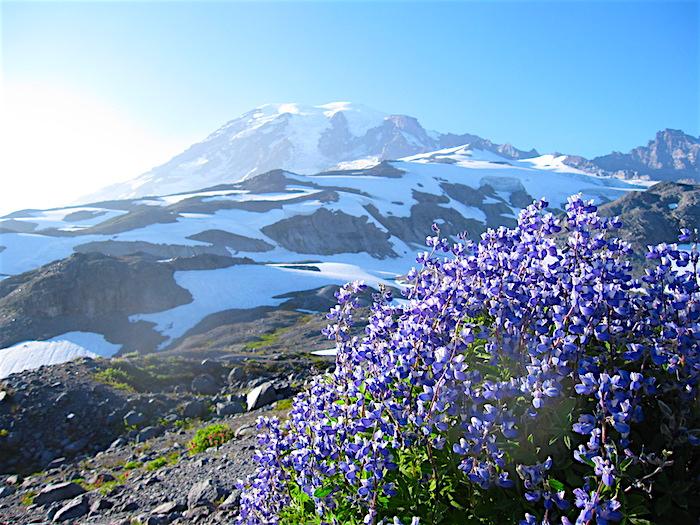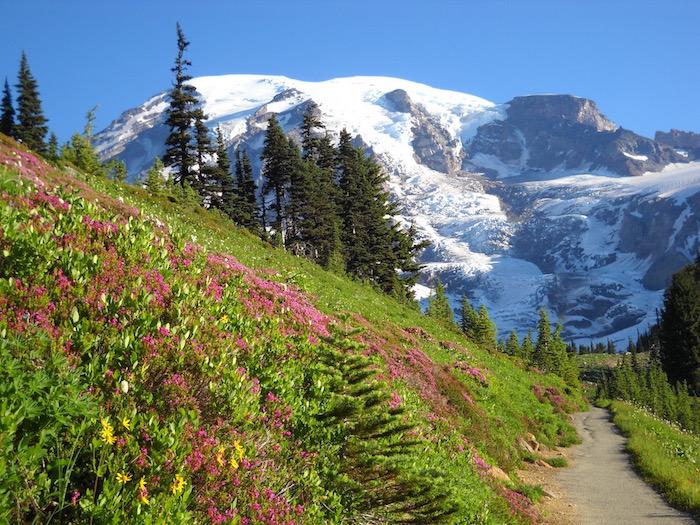
Climate change is driving changes in the blooming of wildflowers at Mount Rainier National Park/Elli Theobald
Riots of blooming wildflowers are one of the joys of visiting national parks, but climate change is tinkering with the schedule of some of those flowers. At Mount Rainier National Park in Washington, for instance, all wildflower species are blooming earlier than in the past, roughly half have extended their season, and a little less than half shortened theirs, according to research conducted by University of Washington personnel.
A trio of ecologists from the university stumbled upon this alteration while collecting data on the subalpine wildflowers that bloom each summer on the slopes of Mount Rainier. As they report in a paper published online last month in the journal Ecology, an unseasonably warm, dry summer in 2015 caused reassembly among these subalpine wildflower communities.
The conditions in 2015 gave the team — consisting of doctoral student Elli Theobald, doctoral student Ian Breckheimer and biology professor Janneke Hille Ris Lambers — a preview of what subalpine communities may look like by the end of this century. By then, significant climate change is expected to permanently alter environmental cues that wildflowers rely upon and make community reassembly a more common phenomenon — with unknown consequences for species interactions in those communities.
"2015 was such an outlier that it gave us a glimpse of what this environment on Mount Rainier might be like toward the end of this century," said Theobald, who is co-lead-author on the paper with Breckheimer. "Conditions were so warm that they affected the flowering time and flowering duration of species, forming communities in 2015 that simply did not exist in the other years of our study."
Their study is one of few to demonstrate evidence for community-level reassembly among multiple species.
"These reassembled communities could potentially change the interactions among wildflowers and other species in this subalpine setting," said Theobald.
For six summers from 2010 to 2015, Theobald tracked environmental conditions and plant behavior for 48 species at 70 field plots, each one square meter, along the southern slope of Mount Rainier. The plots ranged from 1,490 to 1,901 meters in elevation. Within each plot, Theobald used sensors to record temperature, snowmelt, and soil moisture content.
"At these elevations on Mount Rainier, snow is the major driver of plant behavior, because the annual cycle of flowering and reproducing cannot begin until the snow melts," said Hille Ris Lambers. "If there is snow on the ground, plants cannot photosynthesize, and if they cannot photosynthesize, they cannot grow."

All wildflower species at the park are blooming earlier, and a little more than half are staying in bloom longer/Gary Vogt file
When the sensors reported that snow had melted at each plot, Theobald collected data on when plants would emerge, flower, and begin to produce fruit. These included species familiar to hikers such as avalanche lily, magenta paintbrush, mountain blueberry, wild huckleberry and wild lupines.
Most of these plants are perennials, which retreat underground each winter. But when snow melts, they typically have a two- to four-month window — depending on elevation and position — to grow, flower and produce fruit and seeds for the next generation before snow returns.
In 2015, conditions were so warm that, on average, snow began to melt at the study plots 58 days earlier than in 2010-2014. The team recorded major shifts in the bloom times of wildflower species. All of the species — 100 percent — flowered earlier in 2015 and 54 percent of species also lengthened their flower duration that year, some by as many as 15 days. The remaining species showed shorter flower duration, in one case by nearly 19 days, possibly due to accelerated soil drying, altered pollinator activity or other factors.
Since species shifted in different ways, conditions in 2015 produced new patterns of reassembled wildflower communities, with unknown ecological consequences.
"These are species that have always coexisted at these subalpine sites," said Theobald. "But in 2015, we saw species flowering at the same time that normally flowered weeks apart."
The team saw the most dramatic signs of reassembly among plants that normally flowered early in the summer. These plants tended to grow at sites experiencing less snowfall — such as plots at lower elevations, or along ridges and slopes instead of coves and valleys, where snow tends to accumulate. In addition, the plants that tended to lengthen flowering duration did so if they experienced a greater number of warm, photosynthetically "productive" days in 2015.
Reassembly on the scale that the researchers saw in 2015 — and that Mount Rainier may see every year by the end of this century — may change interactions among species. For example, plants could compete for access to pollinators, which at Mount Rainier include bumblebees, flies and hummingbirds.
"We simply don't yet have enough information to know who the 'winners' and 'losers' of reassembly will be, or even what 'winning' or 'losing' in such a scenario would look like," said Theobald.
To predict that, scientists must observe and test how ecological reassembly affects reproduction for all species in these regions — from flowers and pollinators, to even the bears that feed on subalpine berries. These effects will also impact the people who visit these sites and try to preserve them.
"All of these interactions among species — and how those interactions will shift due to climate change — will affect how we manage these sites," said Hille Ris Lambers. "After all, Mount Rainier is a national park that is here for all of us, as well as the species that call it home."

Glacier lilies in bloom at Mount Rainier/Rebecca Latson file



Comments
Actually, our favorite channels are PBS, Smithsonian, National Geographic, and the History Channel, where recently we learned that the Yellowstone Super Volcano remains a threat. Were that to blow (the magma chamber is 40 miles across), we can kiss everything on the planet but cockroaches goodbye. But yes, the parking problem in Yellowstone National Park would be resolved!
That's the thing about predictions. We can predict anything we want. But on something as dynamic as the Earth every prediction is bound to change. It certainly makes for interesting television, though! One moment we're hearing that the ice sheets are melting, the next that they are just as likely to come roaring back. Will NOVA make up its mind on that one? No, because who knows when the next super volcano will blow--or two or three big ones blow together with much the same effect?
If Al Gore had just stayed away from "predictions," he could have built a better case. We need to be mindful of climate change, but of course. We need to be mindful when we notice longer falls and shorter winters, earlier springs and hotter summers. But why say we in Seattle will be drowning if we don't build more wind farms NOW! 15,000 years ago, we were covered in ice--3,200 feet of it, to be exact. There wasn't a cat in the house--or anything else, for that matter. Did we learn anything from that? No. The City Council instead approved a waterfront tunnel across the Seattle Fault. If they were so worried about global warming, why weren't they worried about earthquakes? That is what might really kill thousands of people today, not Al Gore's predictions about "tomorrow."
When Al ran for Mayor, his opponent scoffed that the fault hasn't "recently" moved. True. It's been 1100 years, but it tends to move every 1,000. Do the math. Should we cats be worried more about a rise in sea levels, or that sleeping giant of a fault?
Now come the wind farms. What are they really? 50 years ago, Seattle had the lowest electric rates in the entire country. Waterpower did it all. Suddenly, the politicians declared that falling water is NOT green energy, and that we have to build these wind farms. A waterfront tunnel across an active fault; wind farms that slice and dice our magnificent eagles, and we in Seattle declare ourselves GREEN! and follow Al Gore like the Pied Piper of Hamelin.
It's enough to make you stop and think. But again, do people ever think? Do they think about cause and effect, or again, do they just react? As for rewriting Genesis, how is that going, good people? You're stuck with the system God gave you, including all of the earthquakes, tornadoes, hurricanes, volcanoes, and floods. Okay. Call it Evolution, then. But you're stuck with it. And Al Gore won't be your savior.
George and Gracie
"wild places" response shows he does not understand the magnitude of change coming.
Al just wants everyone to like his little story about his cute cats. How nice!
Well, let's talk about "magnitude," Argalite, starting with a statistic from when I was born. There were then just 2.5 billion people on the planet, and just 150 million in the United States. "We" were called the Baby Boom--and we boomed so fast demographers predicted there would be 400 million people in the US by the year 2000. It didn't happen, but we're currently at 325 million, the difference being The Pill. Sorry, ladies, but you know the truth of that. Without the pill there would have been no "equality."
You want me to fret about change, Argalite? I'm been fretting ever since I read Paul Ehrlich's THE POPULATION BOMB (1968). Al Gore can't hold a candle to that book. Oh, I know. There was this little thing called The Green Revolution, where we pretended that population no longer matters. Well, it does matter--and matters a lot. We only kid ourselves by saying it doesn't.
But we like to kid ourselves. It's what pays. When we build wind farms, it makes millionaires of someone; indeed, don't think for a moment it's to head off climate change. Warren Buffett told the truth about that. If it weren't for the subsidies he wouldn't be building wind farms, either.
Yes, George and Gracie are cute cats. And smarter than the average cat, as you can see! So far, we have stabilized the US cat population at around 50 million. Dogs are about the same. As for us, we keep growing and growing, only to charge climate change as the culprit, or in New Zealand's case, apparently, an excess population of cats.
Fine, Kill all the cats. Then watch the rat population soar. To a feral cat a bird is just an hors d'oeuvre. A rat makes an entire meal.
You bet. Big changes are coming. But they won't be just fire and ice. They will include all of the "side effects" of population growth these past 50 years, or as Garrett Hardin added, they will hardly be off to the side.
Do so appreciate your posts, Alfred (and EC). Always the unexpected consequences of reality verses utopian theory. The learning curve. May it come sooner than later to all of us but to those that have been playing us, just bugger off.
Sorry about the duplicate.
I don't want anyone to fret. Just kill the outdoor cats and keep jack russels as pets. I read the population bomb when it came out.
I have hope for alternative fuels such as wind and solar, as these have the potential to power the world. Hydropower is good only when the dams are designed to minimize impacts to aquatic life, just like wind power and flying things.
I have the same hope, meanwhile fossil fuels ARE powering the world and doing it much more efficiently.
And apparently, not with ill effect.
http://dailycaller.com/2017/11/29/study-satellites-show-no-acceleration-...
Once again the "settled science" models are proven wrong.